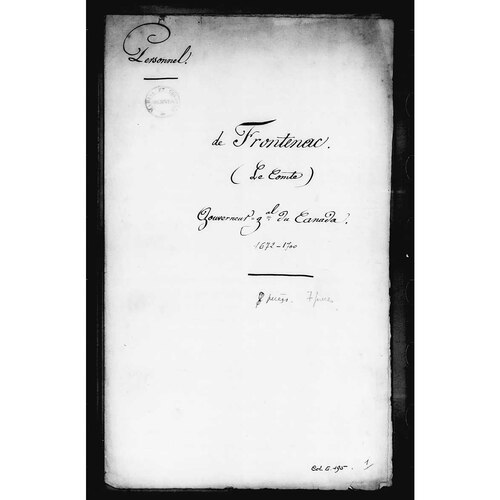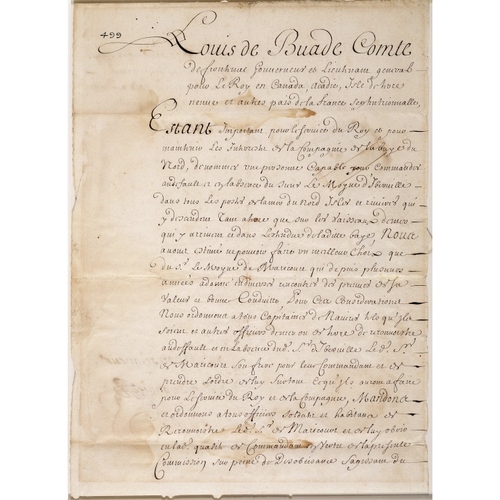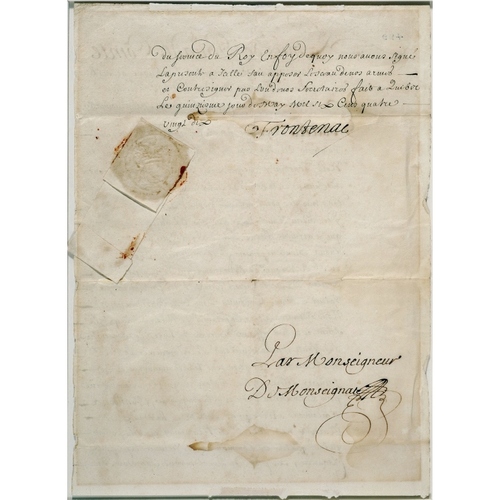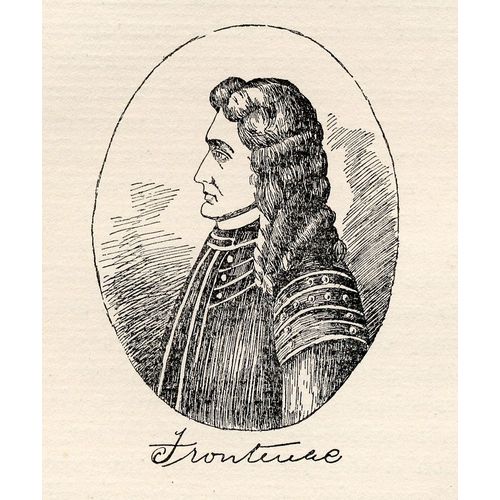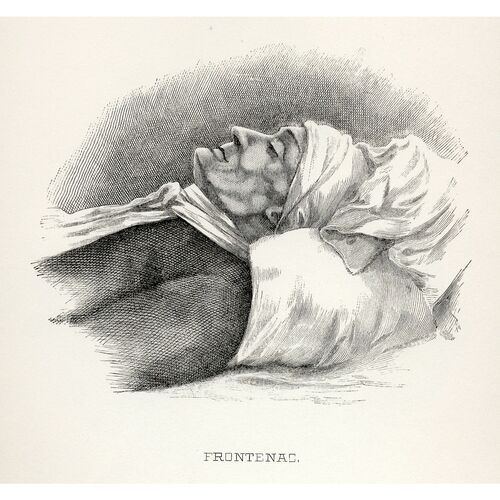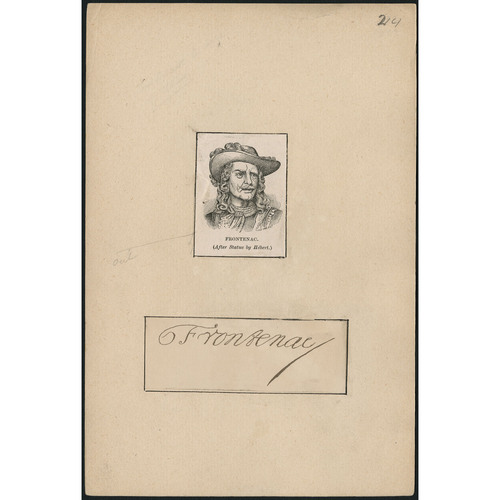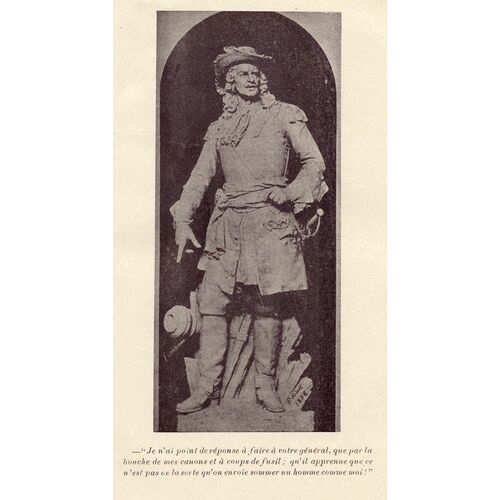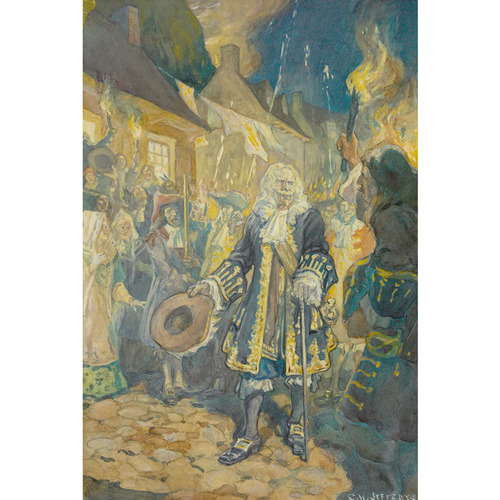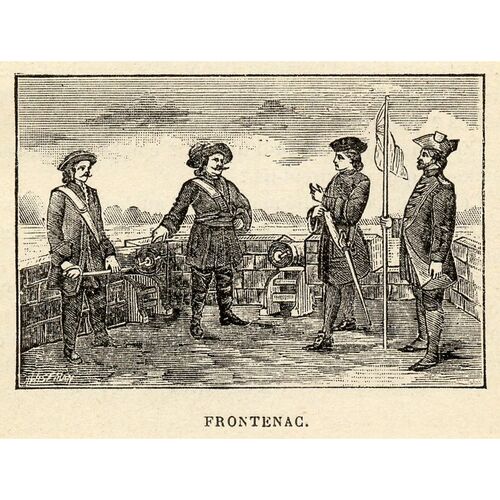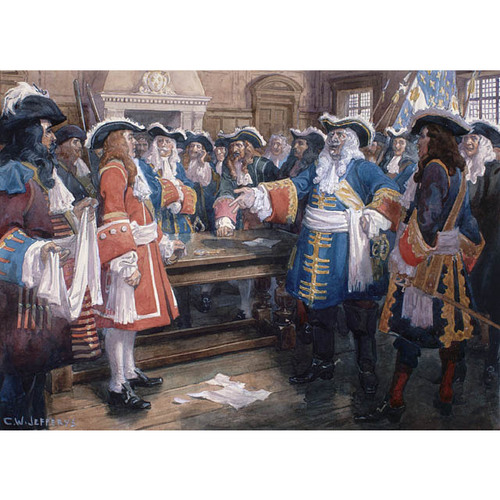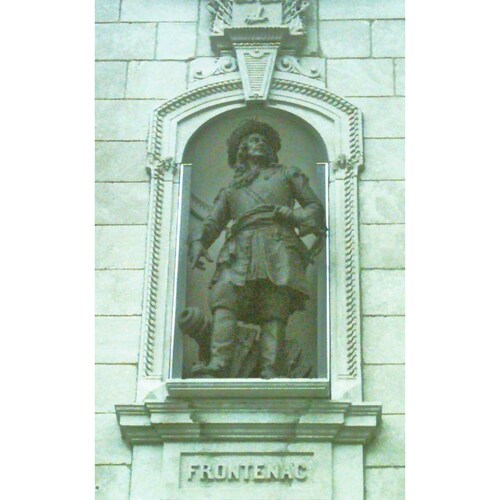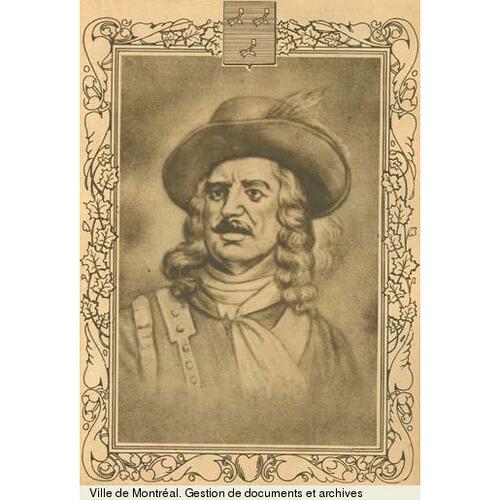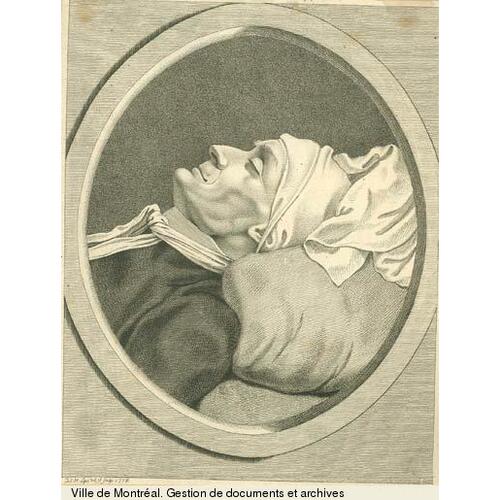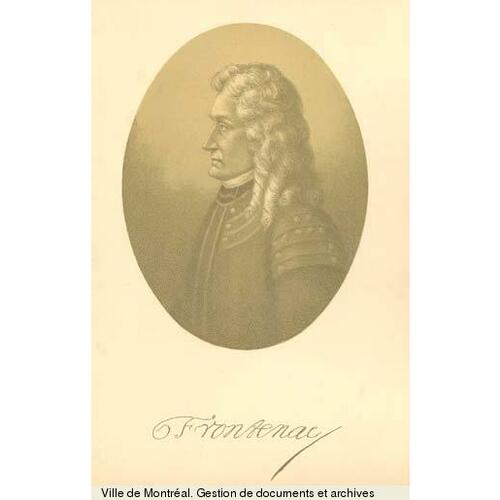BUADE, LOUIS DE, Comte de FRONTENAC et de PALLUAU, soldier, governor-general of New France; one of the more turbulent and influential figures in the history of Canada, chiefly noted as the architect of French expansion in North America and defender of New France against attacks by the Iroquois confederacy and the English colonies; b. 12 May 1622 at Saint-Germain-en-Laye, after the death of his father; d. 28 Nov. 1698 at Quebec, buried in the church of the Recollets at Quebec. He was a son of Henri de Buade, Comte de Frontenac and Baron – later Comte – de Palluau, and Anne Phélypeaux de Pontchartrain, who was the daughter of one secretary of state and niece of another. He was baptized 30 July 1623 at Saint-Germain-en-Laye, with Louis XIII as his godfather. He had at least two sisters. All that is known of one is that she was a nun at Dourdan; the other was married to the Marquis de Saint-Luc, son of Maréchal de Saint-Luc, chevalier of the order of Saint-Esprit and lieutenant-general of Guyenne.
The Buades were an old family of the noblesse d’épée, known in Périgord since the end of the 13th century. The fief from which they derived the title “Frontenac” was situated in Guyenne, between Agen and Castillones. Antoine de Buade, Frontenac’s grandfather, a chevalier of the order of Saint-Esprit, served as Henri IV’s personal equerry for several years before being appointed governor of Saint-Germain-en-Laye and premier maître d’hôtel du Roi. His son, Henri de Buade, was colonel of the regiment of Navarre and a member of Louis XIII’s entourage.
Where Frontenac was educated is not known. It is known, however, that he attended for several years the same college as the Abbé Tronson, the superior of the Messieurs de Saint-Sulpice; very likely they were educated at a Jesuit college, then the best in Europe. Certainly Frontenac’s correspondence indicates that he had received a very good education. While still in his teens he entered the French army, served in several campaigns in the Thirty Years’ War and in February 1643 was commissioned colonel (maître de camp) of the Normandie regiment. While in command of this regiment at the siege of Orbitello in 1646, his right arm was permanently crippled. As recompense, he was given the rank of maréchal-de-camp, equivalent to the rank of brigadier in the present-day Canadian army. Unless he were left-handed, however, and his handwriting does not suggest that he was, his injury could not have been too serious since there is no discernible difference in his handwriting before and after the event. Unfortunately, no authentic portrait of him is known to exist and none of his contemporaries who mentioned him in their writings gave any hints as to his physical appearance. If he resembled his grandfather, whose portrait is in the Bibliothèque Nationale, he was a small, wiry man with a wide forehead, long thin nose, hollow cheeks, and narrow pointed chin; altogether rather unprepossessing.
When not on active service Frontenac resided at the royal court. Like so many of his class he lived extravagantly and became encumbered with debts. In October 1648 he secretly married Anne de La Grange, daughter of the seigneur de Trianon et de Neufville, a wealthy maître des requêtes. She was noted for her rare physical beauty – her portrait hangs in the palace of Versailles – a very imperious temperament, and a quick, biting wit. In addition, apart from her father’s estate, reputed to be worth some 200,000 écus – over 1,000,000 dollars in present-day funds – she stood to inherit a considerable fortune left in trust for her by her mother until she came of age. Frontenac’s father-in-law had placed every obstacle in the way of the marriage, even incarcerating his daughter in a convent to prevent it. When he learned that the marriage had nevertheless taken place clandestinely, he disinherited his daughter and eventually, by means of legal chicanery, prevented her from obtaining the inheritance due to her from her mother’s estate. In May 1651 the Frontenac’s only child, François-Louis, was born, and after the custom of the age and his class the child was reared by servants. Frontenac, at about this time, became a member of the entourage of Gaston d’Orléans, the uncle of Louis XIV, who had the well-earned reputation of being the most treacherous man in France. The Comtesse de Frontenac joined the entourage of Gaston’s daughter, Mlle de Montpensier, shared the adventures of the turbulent “Grande Mademoiselle” during the Fronde, and accompanied her to the provinces as a lady-in-waiting when she was exiled from the court. Mademoiselle eventually came to suspect that Frontenac and his wife were intriguing against her and the Comtesse de Frontenac was dismissed from her household.
Frontenac and his Comtesse then took up residence in Paris where their time was spent at the court, living well beyond their means. His extravagance, even in the extravagant court circles, was the subject of comment. In her memoirs Mlle de Montpensier remarks on his expensive tastes and his colossal vanity. In the summer of 1653 she spent a few days at his château at l’Île Savary, which she described as being “fine enough for a man such as he.” When he showed her the plans he had made for the embellishment of his château she tartly commented: “One would have to be minister of finance to execute them.” On another occasion she depicted him as affecting to hold a court at Saint-Fargeau, one of the royal châteaux where she resided, and of his expecting to be treated as a grand seigneur by all who came to dine with him. This she regarded as ridiculous and remarked: “Frontenac praised everything that he owned; he never came to dinner or supper without talking of some dish or new preserve that he had been served, crediting it to the excellence of his staff. Even meat, according to him, had a different taste at his table to what it had elsewhere. . . . Everyone who came to Saint-Fargeau he took to see his stable and in order to please him one had to praise his very indifferent horses; in short, he is like that in all things.”
In 1653 Frontenac had to sell or relinquish the colonelcy of his regiment and by 1664 his debts were far in excess of 350,000 livres. In that year he legally bound himself to repay that much of his debts within four years, but he made no attempt to honour the commitment. He succeeded in evading his creditors by accepting an appointment as lieutenant-general with the Venetian forces in Crete which were defending the island against the Turks. In June 1669 he sailed for Crete to take up this appointment, accompanied by his son who served as one of his aides-de-camp. He was not long with the Venetian army, however, before he began quarrelling with the other senior officers and he quickly came to be regarded with dislike and distrust by Francesco Morosini, captain-general of the Venetian forces and one of the foremost soldiers in Europe. Eventually, in September, he was dismissed from the Venetian service and ordered off the island by Morosini.
Some three years later, in the spring of 1672, Frontenac obtained the appointment as governor-general of New France. Although the salary and perquisites of the post were meagre indeed to one of Frontenac’s habits, being only 24,000 livres a year, the appointment effectively blocked his creditors’ attempts to seize his properties, for along with his commission as governor-general he obtained an order from the Conseil d’État lifting the seizure placed on his properties and deferring his legal obligation to repay his debts. This was by no means an unusual procedure in the circumstances and no stigma was attached to Frontenac’s bankrupt condition.
On 28 June 1672, Frontenac sailed from La Rochelle for New France. His wife did not accompany him but Frontenac had his salary as governor-general paid directly to her, and throughout his career in Canada she used her not inconsiderable influence at the court on his behalf. She appears, in fact, to have been of greater assistance to him in this way than she could have been as his châtelaine at Quebec. It has been claimed that his relations with his wife were far from amicable, but this claim is based largely on the memoirs of the Duc de Saint-Simon, who wrote some 35 years after the incidents he mentioned and was obviously recalling rather ancient court gossip. Mlle de Montpensier, in her memoirs, states that on one occasion Mme de Frontenac had displayed a marked aversion for her husband, refusing to share his bed, but she also makes it plain that on other occasions no such aversion existed. Thus, there would appear to be little foundation to the statements that they could not abide each other; in fact, considering that in the age and society in which they lived marital fidelity was something to be sneered at, their relations appear to have been surprisingly good.
Rémy de Courcelle, the retiring governor of the colony, had already left when Frontenac arrived at Quebec in the early autumn and Jean Talon, the intendant, sailed for France in November. Perhaps because he had spent most of his adult life in the army, where as colonel of a regiment his word had been virtually law, Frontenac failed to realize that even though he was the governor-general of the colony and the representative of Louis XIV, there were distinct limits to his authority. The administrative system of the colony, established by Louis XIV and Colbert, the minister in charge of colonies, was very similar to that existing in the provinces of France. There were some significant differences owing to the colony’s remoteness from the seat of government in France and the conditions peculiar to North America, but there was a separation of powers of the senior officials. Frontenac, as governor, had complete control over military matters; he also had a veto power over the decisions of the other officials, but this last he could use only in extreme circumstances. He was instructed by the minister not to usurp the functions of the intendant, the Conseil Souverain, or the officers of justice in the lower courts.
Normally, the intendant was responsible for all matters concerning justice, finance, and general administration; it was this official who had authority in all civil matters. But with the intendant absent from the colony, and in view of Colbert’s failure to appoint a deputy or to issue instructions concerning the derogation of the intendant’s powers, Frontenac, not without reason, assumed that these powers devolved upon him. The manner in which he used these powers, however, soon brought him into conflict with the Conseil Souverain, the governor of Montreal, and several of the leading families in the colony.
Some of the more serious of these disputes centred on the fur trade. A few years prior to Frontenac’s arrival peace had been made with the powerful Iroquois Confederacy. This had made it possible for the Canadian fur-traders to voyage into the west to obtain furs from the Indian tribes of the Great Lakes area. Jean Talon had espoused an expansionist policy; he had sent parties to the west to explore, to claim the western lands for France, and to establish trade relations with the Hurons, Ottawas, and other tribes. He had wanted to establish fortified posts in the west and to create a vast fur-trading empire extending far into the interior of North America. Colbert, however, had opposed this policy. This far-seeing minister desired to establish the colony in the valley of the St. Lawrence on a firm basis before undertaking any such expansion. Frontenac was quick to see the latent possibilities in the western fur trade. Before he had been in the colony a year, and without informing the minister of his intentions, not to mention obtaining authorization, he established a fur-trading post on Lake Ontario, at the mouth of the Cataracoui River – where the city of Kingston stands today. The merchant fur-traders and habitants of Montreal were incensed by this, the former because they feared that this advanced trading post, called Fort Frontenac (or sometimes Cataracoui), would forestall them and deprive them of some part of the western fur trade; the ordinary habitants because Frontenac had called them out on corvée and obliged many of them to spend a good part of the summer in constructing the fort and transporting supplies to it. Consequently, during the autumn and winter of 1673 the people of Montreal were in an ugly mood. The governor of the town, François-Marie Perrot, himself an active participant in the fur trade, did all he could to foster this mood in an effort to hinder Frontenac’s attempts to gain control of a large part of the western fur trade. To stifle this opposition and to maintain his authority Frontenac had Perrot arrested, under rather dubious circumstances, and charged with defying the authority of the governor-general. When the case was brought before the Conseil Souverain Perrot defended himself very ably. Meanwhile, in Montreal, a member of the clergy, the Abbé Fénelon [see Salignac], spoke out from the pulpit in criticism of Frontenac’s actions and he too was arrested. Despite the great pressure that Frontenac brought to bear on the members of the Conseil Souverain they finally concluded that the issues involved were beyond their jurisdiction; they ordered that the cases should be referred to the king and that Perrot and the Abbé Fénelon should be sent to France to answer the charges laid against them. Louis XIV and Colbert, after studying the evidence, concluded that all concerned had been at fault, especially Frontenac, and he was severely censured for his actions.
Colbert now took steps to check Frontenac in these abuses of his authority. He appointed an intendant for the colony, Jacques Duchesneau, who was empowered to act as president of the Conseil Souverain and to perform all the other functions of a provincial intendant. This meant that Frontenac’s authority was restricted to military matters and to supervising, but not interfering with, the other officials. At the same time the governor-general’s power to appoint members of the Conseil Souverain conjointly with the bishop was removed. They were now granted royal commissions and all future appointments were made by the king. This made the Conseil Souverain virtually an independent body, able to defy the governor on occasion. In a negative sense Frontenac can be given the credit for this important development.
Frontenac, however, was bitterly resentful because his authority had been curbed and it was not long before he became embroiled in bitter disputes with the intendant and the Conseil Souverain. On one occasion he arbitrarily imprisoned the clerk of the court; on another he had a Montreal judge who had annoyed him incarcerated for two months and fined 200 livres. Then, during the winter of 1678–79, he attempted to reduce the intendant and the Conseil Souverain to subservience. The dispute began when Frontenac claimed the powers that were specifically denied him by the king’s Déclaration of 1675, to preside over the meetings of the council. When, in July 1679, the Conseil Souverain refused to accede to this demand, he exiled from Quebec the attorney general, Ruette d’Auteuil, and two councillors. They were ordered to remain at designated seigneuries outside Quebec until the ships sailed in November, then to cross to France to account to the king for their refusal to submit to their governor’s direct command. During this time the work of the Conseil Souverain was completely disrupted. Only one of the three officials was finally obliged to go to France but his account of events convinced Louis XIV and Colbert that Frontenac had been in the wrong. It took all the influence that Frontenac’s friends at court could bring to bear, and their assurances that he would not be guilty of such excesses in future, to prevent his recall.
The Conseil Souverain had scored a decisive victory over Frontenac; its members had resisted vigorously his attempts to reduce them to subservience and they had been upheld by Louis XIV and Colbert. Thus emboldened, they now began prosecuting some of Frontenac’s associates for infringements of the royal edicts governing the fur trade. After establishing the post on Lake Ontario, Frontenac had become closely associated with Cavelier de La Salle, to whom he gave every assistance in the establishment of a monopoly of the fur trade in the vast area south of the Great Lakes. In expanding French control into the west in this fashion, Frontenac’s associates came into conflict with the Iroquois who were determined to seize the Ohio valley area for themselves. Until 1675 the Iroquois had been unable to oppose the establishment of French posts on lands they either regarded as their own or coveted, owing to their war with two powerful tribes to the east and south of them, the Mahicans and the Andastes. By 1675, however, they had forced these tribes to come to terms and were now able to resist French encroachment. From this date on they became increasingly more hostile. They began attacking Indian tribes allied to the French and under French protection. When these tribes appealed to Frontenac for aid he offered none; instead he tried to appease the Iroquois, which merely emboldened them to begin pillaging French canoes and attacking French posts in the west. At the same time another threat to New France was developing in the north. The recently established Hudson’s Bay Company was inducing Indian tribes that usually traded with the French to take their furs to the Company’s posts on the Bay. Some in the colony advocated strong measures to remove this threat, but Frontenac refused to allow any action that might cause strife with the English.
It was at this juncture of events, in 1682, that Frontenac was recalled to France. It was not, however, his failure to cope with these military and economic threats that caused the king and the minister to dismiss him, for they were unaware of the seriousness of this situation; it was his continued wrangling with the intendant, the Conseil Souverain, and the clergy. In the case of the latter group, the underlying causes of the trouble were the fur trade and the anti-clerical attitude of the court in general and Colbert in particular. The Jesuits were Colbert’s bête noire; he was convinced that in both France and New France they wielded far too much influence and were attempting to establish a theocracy in Canada. Thus, when a dispute arose over the unrestricted sale of brandy to the Indians, Frontenac was easily able to convince Colbert that this was merely another example of the clergy’s continual attempts to encroach on the royal authority. The clergy, and particularly the Jesuits since they were mainly concerned with missionary activities among the Indians, were adamant in their opposition to the use of brandy in the fur trade, claiming, with good cause, that the Indians were cheated out of their furs by unscrupulous traders who first got them drunk; that they became utterly debauched and committed the most heinous crimes when brandy was brought into their villages. Bishop Laval* had declared the trading of brandy to the Indians to be a mortal sin and those known to have engaged in the practice were denied the sacraments of the church. Frontenac, along with many but by no means all of those engaged in the fur trade, regarded brandy as necessary for the trade and he accused the bishop of interfering in civil affairs and the Jesuits of desiring to gain control of the fur trade for themselves. Louis XIV eventually tried to settle the dispute with a compromise decision which was easily evaded, consequently the clergy continued to complain of Frontenac’s attitude and he, in turn, did his best to discredit them.
Although in his disputes with the clergy Frontenac had the support of Colbert, in his violent quarrels with the intendant and the Conseil Souverain he did not. In 1680 the minister informed him that all the public bodies and many individuals were complaining of his tyranny. New France, Louis XIV wrote on 29 April 1680, “runs the risk of being completely destroyed unless you alter both your conduct and your principles.” The following year he was warned that unless he changed his ways, it would be necessary to recall him. But Frontenac proved incapable of heeding warnings or orders. In violent displays of temper he imprisoned, first the teen-age son of Intendant Duchesneau, then Mathieu Damours de Chauffours, an elderly member of the Conseil Souverain, for what he claimed were failures to show due respect for his person. Thus, it came as no surprise to anyone that he was dismissed from his post and ordered to return to France.
When he left the colony the civil administration was in a turmoil as a result of his wrangling. The fur trade had been divided between two rival and warring factions, that of Frontenac and his associates and that of the Montreal fur-trading merchants. Some of the latter group were also Frontenac’s enemies in the Conseil Souverain. To some extent Frontenac was sinned against as well as sinning. His opponents had found it very easy to annoy and incite him to the excesses that resulted in his recall, but in the final analysis his lack of self-control was his downfall. His most serious fault, however, was his failure to take effective action in the face of the Iroquois threat. The danger had become very real that, as a result of his inaction, the French would be driven out of the west, that their hold on the fur trade, which was the economic life blood of the colony, would be lost, and that the Iroquois would, before long, launch attacks on the colony proper. Frontenac had failed to take any precautions in the face of this threat; the colony was virtually without defences. The settlements were very scattered; there were no fortified places where the settlers could find security in the event of attack; and the militia was untrained and without arms.
This was the situation that confronted Frontenac’s successor, Le Febvre de La Barre, and it proved too much for him. Unable to cow the Iroquois with the forces available, he was obliged to make peace on their terms and in consequence he was recalled by Louis XIV. He had, however, at least succeeded in making the king and the minister of Marine realize the seriousness and urgency of the situation in Canada. M. de Brisay* de Denonville was now sent out as governor, with a considerable body of troops, and he succeeded in bringing the Iroquois to accept his terms for peace. Before this treaty could be ratified, however, the war of the League of Augsburg broke out in Europe and the Iroquois learned from the New York authorities that France and England were at war before the news was received in Canada. Thus, a surprise attack by the Iroquois on the settlements at Lachine on 4 Aug. 1689 caught the Canadians unawares. Heavy casualties were inflicted and many farms destroyed.
Meanwhile, in France, Frontenac had for some time been striving to convince Louis XIV and his ministers that he merited another appointment. In this endeavour he was ably assisted by his influential friends and relatives at the court. He must have been living in very straitened circumstances for his creditors appear to have succeeded, at last, in seizing most of his properties. In 1685 he had received a gratuity of 3,500 livres which could have been but small financial comfort to a person accustomed to consuming well over ten times that amount in a year. Then, in 1688, Denonville sent his second in command, Louis-Hector de Callière*, the governor of Montreal, to Versailles to report on the state of affairs in the colony and to submit plans for a combined land and sea attack on New York, this last being regarded as the most effective way to bring the Iroquois to heel by denying them the supplies they needed to attack the French. As soon as England declared war on France Louis XIV had accepted this proposal and Frontenac was appointed to command the expedition. He was, at the same time, appointed to replace Denonville as governor of New France. He had received this appointment in April 1689 some four months before the Iroquois launched their sudden attack in August on the settlements at Lachine. Thus it would not be correct to claim that Frontenac was reappointed governor of New France to save the colony from disaster. He was reappointed because Denonville was worn out by his exertions and had asked to be replaced. Frontenac’s own influence and that of his friends at the court was sufficient to obtain the appointment for him. Moreover, with France at war against a coalition of European powers, the better military commanders could not be spared for service in Canada, even had they been willing to accept the appointment.
The expedition against New York, with Frontenac in command, was delayed six weeks at La Rochelle owing to lack of crews for the ships. When it finally sailed on 23 July it encountered strong head winds and did not reach Quebec until 12 October. It was, by this time, too late in the season to undertake the overland assault on Albany and Manhattan and the enterprise was abandoned. When Frontenac now took stock of the situation with which he was faced, it was anything but reassuring. He had to defend the colony against the Iroquois who were continuing their devastating attacks on the settlements; face the possibility of attacks by the English colonies; and at the same time afford military aid to the Indian allies in the west. He had under his command a sizable force of regular troops, some 1,400 in all, as well as the Canadian militia, and in addition he had three very capable men to assist him: the intendant Jean Bochart* de Champigny, Louis-Hector de Callière, the governor of Montreal, and Philippe de Rigaud* de Vaudreuil, commander of the regular troops. They were men of exceptionally strong character, not lacking in influence at the court – Callière’s brother, for example, was one of Louis XIV’s private secretaries – thus Frontenac had to defer to their judgement in many things. At the same time, he was in a much stronger position than he had been during his first term as governor, for within a year of his appointment, the Marquis de Seignelay, Colbert’s son and successor, died and was succeeded by Frontenac’s kinsman, Louis Phélypeaux de Pontchartrain. When Frontenac learned that his relative had been appointed minister of Finance and minister of Marine, his personal ambitions and expectations rose considerably. The position of governor-general of New France, so eagerly sought after a short time earlier, now seemed inadequate. Immediately upon hearing of Pontchartrain’s appointment he wrote to request that he be given a more important and less arduous post. He stated that he was confident the minister would not wish to see a member of his own family fall into decrepitude and end his days without adequate means, without befitting dignity, and without the distinction his long services merited. This plea met with no response from the minister, although it was repeated year after year.
The Iroquois Confederacy responded in a similar fashion when Frontenac attempted to arrange a peace settlement with its member tribes. He greatly over-estimated his influence over them and their only reply was to torture to death some of his emissaries, whereupon they renewed their attacks on the Canadian settlements. The Canadians found it extremely difficult at first to parry these surprise assaults but their other foe, the English colonies, which were supplying the Iroquois with arms and urging them on in these attacks, could be dealt with. Before Frontenac’s return to the colony the Canadians had been eager to attack Albany, the main supply base for the Iroquois, and had this town been destroyed the Iroquois would have been rendered impotent for a time. Frontenac was quick to see that a military victory against the English would raise morale in the colony and his own prestige as governor. In January 1690 he mustered three war-parties to ravage the English border settlements, but instead of concentrating the assault against Albany, as many in the colony urged, he had his forces attack three small settlements at widely scattered points: Schenectady in New York, Salmon Falls on the Maine Coast, and Fort Loyal on Casco Bay. At all three places the farms and homes were destroyed, many of the English settlers killed, and some prisoners taken. These raids succeeded admirably in raising morale in New France and spreading terror along the English colonial frontier, but they also spurred the English colonies to unite their forces for a combined land and sea assault on Canada. Their plans called for a large force of militia from New York, New England, and Maryland to unite with the Iroquois for an attack on Montreal while a maritime expedition sailed from Boston under the command of Sir William Phips, to attack Quebec by way of the St. Lawrence. Owing to poor organization and an epidemic of smallpox in the ranks of the militia, the large-scale assault on Montreal had to be abandoned; consequently when word reached Frontenac at Montreal that a Boston fleet was approaching Quebec he was able to concentrate all the military forces in the colony on the defence of the town. On 16 October an officer from the Boston fleet came ashore and was taken before Frontenac and his senior officers and officials. This emissary delivered an ultimatum from Phips demanding the surrender of the colony within the hour, failing which Quebec would be taken by force of arms. To this Frontenac replied with the ringing phrase: “I have no reply to make to your general other than from the mouths of my cannon and muskets” (AN, Col., F3, 7, f.40).
This brave defiance heartened the defenders of Quebec and dismayed the New England forces. When the latter learned that the entire military forces of the colony awaited their assault, their military ardour faded appreciably. They put over a thousand men ashore on the Beauport flats, facing Quebec across the St. Charles River, but failed to launch an attack and after three days of marching and repelling forays by small bands of Canadian militia, with the weather growing bitterly cold, they finally returned to their ships and sailed away. Frontenac had thus successfully defended Quebec and the colony with the minimum of casualties by merely sitting tight. No battle had been fought and the enemy’s withdrawal took Frontenac by surprise, but it was a decisive victory none the less. The English colonies launched no more full-scale assaults on Canada; for the ensuing seven years of war they relied on the Iroquois to do their fighting for them. Nor were Canada’s military forces sufficient to invade the English colonies in strength. Frontenac therefore pursued a policy of guerilla warfare and the Canadians quickly became as adept as the Iroquois in this forest war of ambush and stealthy attack, where to be taken prisoner meant subjection to the worst forms of torture that could be devised by savage minds.
Frontenac played little part in this aspect of the war. The actual war-zone comprised the French settlements from Montreal to Trois-Rivières and the fighting was done by war-parties sent out from Montreal to attack the Iroquois on their own territory. The men responsible for the tactical direction of this petite guerre were Callière and Vaudreuil. Both were competent men and Frontenac did not interfere with them. To some extent this is a tribute to the strength of their characters; it is also a tribute to Frontenac’s judgement, and for this he deserves credit.
For most of the year Frontenac resided at the Château Saint-Louis in Quebec, making only the occasional trip to Montreal when the Indian allies came from the west to confer with him – always an occasion for feasting and long speeches, which Frontenac appeared to enjoy. At Quebec he maintained a large establishment: a corps of guards, two or three secretaries, a chaplain, a physician, and a large number of servants. Although it would be ridiculous to assume that the Château Saint-Louis was a small-scale Versailles, Frontenac did entertain lavishly and in consequence he was popular with the ladies of Quebec. He held frequent banquets and receptions; when the ships from France arrived with the year’s supplies, and perhaps word of fresh victories won by the armies of Louis XIV on the battlefields of Flanders or the Rhineland, then Frontenac would have a Te Deum sung, order all the houses in the town to be illuminated, salutes to be fired from the ships in the river below, and a display of fireworks. During the winter amateur theatricals were held at the château and some of the parts were taken by the ladies, to the horror of the clergy. On one occasion, when the bishop learned that Molière’s Tartuffe – a biting satire on religious bigotry – was to be enacted, he raised a great outcry, excommunicated Jacques de Mareuil who was to take the leading role, and had the whole colony in an uproar. Louis XIV had to intervene before calm was finally restored.
During these years Frontenac made the expansion of the fur trade his main concern and the war greatly facilitated this expansion. Under the guise of military activities he sent large forces to the western posts each year, paid for by the Crown. It soon became apparent that far from serving any military purpose, these expeditions merely afforded an opportunity for Frontenac’s friends and associates to gain wealth by trading furs. The western Indians were kept fully occupied hunting beaver and had no time to carry the war to the Iroquois. New fur-trading posts were established in the west and the Canadian traders began to push beyond the forest belt to the great plains west of the Mississippi and around Lake Winnipeg. The Ottawa Indians, traditional commercial partners of the French, became very disgruntled by this expansion; they had been the middlemen, collecting furs from the tribes in the west to trade to the Canadians. Now the Canadian coureurs de bois were obtaining the furs directly, eliminating the Ottawas as middlemen. Worse still, the Canadians began trading with the Sioux, traditional enemies of the Ottawas, and supplying them with firearms. Thus, when the Iroquois approached the Ottawas to make peace and form an alliance against the French, their overtures were welcomed. The French commercial empire in the west was now in jeopardy. French officers and missionaries at the western posts and the senior officials at Montreal and Quebec began appealing to Frontenac to take swift action to counter this grave danger. They demanded that he organize a full-scale assault on the Iroquois villages, claiming that this was the only effective way to prevent disaster. Frontenac, however, was extremely reluctant to undertake the campaign. The Iroquois, while negotiating with the Ottawas, had kept the French inactive by entering into peace negotiations with Frontenac who believed them to be sincere, despite the efforts of Callière and the intendant to convince him that he was being duped. It was only after the Iroquois had brought the Ottawas to terms, then renewed their attacks on the French settlements, and after Frontenac had received direct orders from the minister of Marine, that he undertook a campaign against the Iroquois villages.
In July 1696 the army, composed of regular troops, militia, and Indian allies from the missions in the colony, numbering in all some 2,150 men, left Montreal with Frontenac nominally in command but with Callière and Vaudreuil in charge of operations. In the final march on the Onondaga village Frontenac, now in his seventy-fourth year, but determined not to be excluded from an active part in events, was carried through the forest in an arm-chair. When the Onondaga village was reached, only ashes remained. The enemy had fled into the forest after burning everything to the ground. The army set to work destroying the corn in the fields and all the food supplies they could find cached in and about the village. Vaudreuil, with over six hundred men, went on to the Oneida village, burned it to the ground and destroyed the crops. This work done the army returned to Montreal. Its total casualties had been three men drowned and one soldier killed by a lurking Iroquois while on the homeward route. Only one Iroquois was killed, an old Onondaga chief, captured because he was too old and feeble to flee. Frontenac permitted the Mission Indians to burn him slowly to death, a fate that he endured without a whimper.
Despite the failure to come to grips with the enemy, this campaign broke the resistance of the Iroquois. During the preceding few years the tide of the petite guerre had turned against them. At the beginning of the war they had been able to attack the French settlements with impunity, but the Canadians had rapidly become skilled in forest warfare tactics. More and more frequently Iroquois war- and hunting-parties were being ambushed on their own territories by Canadian war-parties; more and more frequently Iroquois warriors failed to return to the long-houses. With their villages and food supplies destroyed, the Onondagas and Oneidas now had to depend on the aid afforded by the three other Iroquois nations and the English colonies. When they appealed to the officials at Albany they received little help, for New York, the frontiers of which had been constantly harassed by Canadian war parties, had little to spare. In addition, the Ottawas, upon seeing the state to which the Iroquois were now reduced, abrogated their treaty and began attacking them anew. Nine years of war and the ravages of disease had already reduced their fighting strength by half, from an estimated 2,800 in 1689 to 1,320 in 1698, while the strength of the French, despite heavy losses from war and disease, had increased from a population of 10,523 in 1688 to 12,768 in 1695. Under these circumstances, and fearing that the French would destroy their remaining villages in further campaigns, they had no alternative but to sue for peace. This time, however, Frontenac was by no means convinced that they were sincere and for another three years the fighting continued intermittently in the forest. In Europe, meanwhile, the War of the League of Augsburg had ended. In February 1698 delegates from Albany arrived to inform the French that the Peace of Ryswick had been signed.
When Frontenac had arrived in New France in 1689 to take up the post of governor-general for the second time, the colony had been reeling under the constant assaults of the Iroquois. Although, with the exception of the defence of Quebec in 1690, he had played little real part in the tactical direction of the war, the responsibility had still been his. Had the colony been conquered he would have been held accountable; since it was successfully defended he deserves credit.
Any assessment of his attitude towards the fur trade is faced with a paradox. The policy of the government in France was to curb the fur trade to prevent its undermining the establishment of the colony on sound economic and social principles. The government wished the Canadians to be concentrated in the central colony, engaged in agriculture, fishing, and such other industries as shipbuilding, lumbering, and the manufacture of some consumer goods. In short, they wanted the colony to be self-sufficient in the essential commodities. They did not want a large segment of the Canadian population to be scattered about at posts in the interior of the continent. Frontenac, however, flouted this policy and under his governorship the fur trade expanded more than ever before; new trading-posts were established in the west, the commands given to his associates and military funds employed to further their trading activities. Clearly, Frontenac’s motives were dominated by the financial interest of himself and his associates. Yet the fact remains that shortly after his death the government at Versailles, for political and dynastic reasons, abandoned the policy of restraining western expansion and adopted instead an imperialist policy of occupying all of North America west of the Alleghenies, between the Great Lakes and the Gulf of Mexico. The western posts established by Frontenac were vital to this new policy; had he not had them built and manned, the government would have had to begin creating them. It would be easy to assume prescience here on the part of Frontenac, but much more difficult to find evidence of it.
Again, in civil affairs, it is by no means easy to form a judgement of Frontenac. Certainly during his second term the administration was not completely disrupted as it had been during his first term as governor. With the exception of one violent dispute with Bishop Saint-Vallier [La Croix*] over the intended performance of Molière’s Tartuffe – and it was the bishop rather than Frontenac who created the furore – his relations with the clergy were relatively peaceful. Nor did he create serious difficulties in the Conseil Souverain; but his relations with the intendant left a good deal to be desired. When Champigny tried to implement the royal edicts designed to curb abuses in the fur trade Frontenac overrode him and was supported by the officials in the ministry of Marine. By 1695, however, the ministry was brought face to face with the fact that the market for beaver in France was completely glutted. The amount of beaver pelts shipped from Canada had risen astronomically during the preceding ten years and the lease on the beaver monopoly expired in 1697. This lease brought 500,000 livres a year into the royal exchequer and there was a serious danger, with the market glutted, that no one would be willing to purchase the monopoly when the existing lease expired. The minister, when he investigated this situation, became convinced that Frontenac’s persistent disregard for the edicts governing the fur trade was the main cause of the trouble. Frontenac’s critics, who for some time had maintained that the huge military expenses incurred by the governor had served, not military purposes, but the extension of Frontenac’s interests in the fur trade, were now believed. In 1692 the colony’s military budget was 75,000 livres; by 1694 it had increased to 200,000 livres. The minister complained that over the preceding few years the excess of expenditures over allotted funds totalled 550,000 livres, and that little appeared to have been accomplished.
In 1697, when Frontenac became involved in a dispute with the intendant over the disposition of a ship prize and annulled his ruling, the minister revoked Frontenac’s annulment, censured him severely, and warned him that he could not continue to protect him by excusing his conduct to the king. The patience of both Louis XIV and the minister was now exhausted. Instead of heeding this warning, however, the following year Frontenac became involved in a fresh dispute with the intendant when he attempted to prevent one of his western post commanders, Lamothe de Cadillac [Laumet*], being brought to trial for flagrant abuses of his authority while at Michilimackinac. During the course of this controversy it became plain that, far from striving to enforce the king’s edicts governing the fur trade, Frontenac had actively encouraged the members of his following, men whom he had commissioned in the colonial regular troops and placed in command at the western posts, to disregard the edicts intended to limit their trading activities. At a time when the minister was striving to reduce the amount of beaver fur produced to the amount that the market could absorb, Frontenac continued to send large parties, loaded with trade goods, to the western posts in defiance of the king’s explicit orders. In the light of these revelations, and the fact that his credit at the court was at a very low ebb, he stood in danger of being once again dismissed from his post. The minister, however, was spared the necessity for making this decision.
For some weeks in the autumn of 1698 Frontenac had been in poor health, suffering from asthma. He had to sleep propped up in an armchair and his strength now began slowly to ebb away. By mid-November he realized that his end was near and he calmly prepared for it. He made his peace with his old antagonists, the intendant and the bishop, and on 28 November the bishop administered extreme unction. Shortly afterwards death came for the old governor and he was buried in the church of the Recollets of Quebec.
He was survived, until 20 Jan. 1707, by the Comtesse de Frontenac, whose declining years were made difficult at times by straitened circumstances. They had no heir; their son, François-Louis, had died in 1672 or 1673 in Germany while serving as colonel in the forces of the Bishop of Münster.
One final point remains: the Frontenac legend. Until recently, only two studies of Frontenac and his régime, based on the original documents, had been made. The one by the American historian Francis Parkman, entitled Count Frontenac and New France under Louis XIV, was first published in 1877; the other, by the French historian Henri Lorin, entitled Le comte de Frontenac – and more a panegyric than a critical historical study – appeared in 1895. Their characterizations of Frontenac, and more particularly that of Francis Parkman, were accepted almost without question by all but a very few later historians and writers. Unfortunately, neither Parkman nor Lorin examined the evidence very critically. Frontenac was a prolific and gifted writer; he sent very lengthy accounts of all that happened in New France to his wife for circulation in court circles. These annual journals, running to 90 pages, were skilfully contrived to make everything redound to the greater glory of Frontenac; every success, no matter how ephemeral, was extolled, and every setback was plausibly explained away or at least minimized. But to accept his account of events uncritically ensured a colourful narrative particularly pleasing to the romantic historians – and reading public – who subscribed to the “great man” concept of history. When, however, Frontenac’s accounts are closely checked against all the available evidence from other sources, the discrepancies, the subtle half-truths, the calculated omissions and the distortions are very apparent.
Unfortunately, most authors of the more recent biographies of Frontenac and general studies of the period, have preferred to paraphrase Parkman rather than to examine critically the evidence contained in the masses of original documents. Thus, they have perpetuated, and enhanced, the Frontenac legend by repeating old errors and, too often, creating new ones.
[Original source material dealing with Frontenac’s pre-Canadian career is rather scanty. There are some items in the Manuscript Division, BN, Paris, and a few documents in the Departmental Archives, Châteauroux. Mlle de Montpensier, in her memoirs, has not a little to say about the Comte and Comtesse de Frontenac, not much of it to their credit (see Anne Marie Louise de Montpensier d’Orléans, Mémoires, éd. A. Chéruel (4v., Paris, 1858–59), II, 279; III, 16–17). Frontenac’s dispatches to the court and those from Louis XIV and the minister to him are printed in APQ, Rapport, 1926–27, 1–144; 1927–28, 3–211; 1928–29, 247–384. To obtain a balanced view of Frontenac and his activities in Canada, however, the correspondence of other officials and notables in the colony must be consulted. The bulk of this material is to be found in AN and BN, Paris; transcripts and microfilm of these documents are available in PAC, Ottawa. Other pertinent documents are to be found in ASQ, AJM, and the state archives at Albany and Boston. A selection of Frontenac’s correspondence, annotated and with a brief introduction, is printed in Guy et Lilliane Frégault, Frontenac (Classiques canadiens, 2, Montréal et Paris, 1956).
There have been several biographies of Frontenac, the first significant one being Francis Parkman, Count Frontenac and New France under Louis XIV, which has run through various editions but which was first published in Boston in 1877. Like most scholars of his generation, Parkman unfortunately judged New France by the values of his own day rather than those of Frontenac’s age. Henri Lorin’s Le comte de Frontenac (Paris, 1895) is little more than a panegyric wherein liberties are taken with historical evidence. Jean Delanglez’s Frontenac and the Jesuits (Chicago, 1939) is an antidote to the anti-clericalism of both Parkman and Lorin. It deals only with the one aspect of Frontenac’s career, however, but is nevertheless quite a sound piece of scholarship. The most recent, and critical, biography of Frontenac is by Eccles, Frontenac: the courtier governor. The biographies by W. Lesueur, Count Frontenac (Toronto, 1906), and Colby, The fighting governor, are based mainly on Parkman’s earlier study and are of little real value. w.j.e.]
Revisions based on:
Arch. en Ligne, Yvelines (Montigny-le-Bretonneux, France), “Reg. paroissiaux et état civil,” Saint-Germain-en-Laye, 30 juill. 1623, juillet 1623: archives.yvelines.fr/decouvrir/archives_en_ligne/index.php (consulted 21 July 2011). Association Frontenac-Amériques, “Le site de l’association Frontenac-Amériques”: www.frontenac-ameriques.org (consulted 21 July 2011).
Cite This Article
W. J. Eccles, “BUADE, LOUIS DE, Comte de FRONTENAC et de PALLUAU,” in Dictionary of Canadian Biography, vol. 1, University of Toronto/Université Laval, 2003–, accessed January 27, 2025, https://www.biographi.ca/en/bio/buade_de_frontenac_et_de_palluau_louis_de_1E.html.
The citation above shows the format for footnotes and endnotes according to the Chicago manual of style (16th edition). Information to be used in other citation formats:
| Permalink: | https://www.biographi.ca/en/bio/buade_de_frontenac_et_de_palluau_louis_de_1E.html |
| Author of Article: | W. J. Eccles |
| Title of Article: | BUADE, LOUIS DE, Comte de FRONTENAC et de PALLUAU |
| Publication Name: | Dictionary of Canadian Biography, vol. 1 |
| Publisher: | University of Toronto/Université Laval |
| Year of publication: | 1966 |
| Year of revision: | 2015 |
| Access Date: | January 27, 2025 |


![Frontenac [image fixe] Original title: Frontenac [image fixe]](/bioimages/w600.1410.jpg)
